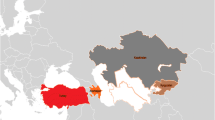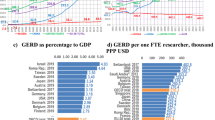Abstract
This paper presents an analysis of scientific research output of the republics of former Yugoslavia for the period 1970–2014. Thomson Reuters’ Web of Science database was used for data acquisition and 223,135 publications have been analyzed. The Yugoslav Wars were ethnic conflicts fought from 1991 to 1999 on the territory of former Yugoslavia which accompanied the breakup of the country and today each republic of former Yugoslavia is an independent country as well as the province of Kosovo. Results of the analysis are represented by four figures depicting relative publication share and for figures depicting normalized cooperation score for each former Yugoslav republics and the province of Kosovo, as well as by four figures depicting cooperation networks between the former Yugoslav republics and the province of Kosovo for the periods before the Yugoslav wars (from 1970 until 1990), during the wars (from 1991 until 1999), in the first decade after the wars (from 2000 until 2009), and in the last 5 years (from 2010 until 2014). The impact of the wars on scientific cooperation in the republics has been studied.























Similar content being viewed by others
References
Aksnes, D. W. (2003). Characteristics of highly cited papers. Research Evaluation, 12(3), 159–170.
Babin, M., Ivošević, V., Lažetić, P., & Miklavič, K. (2009). Finansiranje visokog obrazovanja u Jugoistočnoj Evropi: Albanija, Crna Gora, Hrvatska, Slovenija, Srbija. Centar za obrazovne politike.
Baltussen, A., & Kindler, C. H. (2004). Citation classics in anesthetic journals. Anesthesia and Analgesia, 98(2), 443–451.
Branković, J., Šabić, N., Babin, M., & Lažetić, M. (2012). Istraživačke politike, finansiranje i produkcija - Hrvatska, Srbija i Slovenija u uporednoj perspektivi. Centar za obrazovne politike.
de Bruin, R. E., Braam, R. R., & Moed, H. F. (1991). Bibliometric lines in the sand. Nature, 349, 559–562.
Đukić, V., Udiljak, N., Bartolić, N., Vargović, M., Kuduz, R., Boban, N., et al. (2011). Surgical scientific publication and the 1991–1995 war in Croatia. Collegium Antropologicum, 35(2), 409–412.
Figg, W. D., Dunn, L., Liewehr, D. J., Steinberg, S. M., Thurman, P. W., Barrett, J. C., & Birkinshaw, J. (2006). Scientific collaboration results in higher citation rates of published articles. Pharmacotherapy: The Journal of Human Pharmacology and Drug Therapy, 26, 759–767.
Fu, H. Z., & Ho, Y. S. (2013). Independent research of China in Science Citation Index Expanded during 1980–2011. Journal of Informetrics, 7(1), 210–222.
Furlan, J. C., & Fehlings, M. G. (2006). A web-based systematic review on traumatic spinal cord injury comparing the “citation classics” with the consumers’ perspectives. Journal of Neurotrauma, 23(2), 156–169.
Glänzel, W., & Schubert, A. (2004). Analysing scientific networks through co-authorship. In H. F. Moed, W. Glänzel, & U. Schmoch (Eds.), Handbook of quantitative science and technology research. Dordrecht: Kluwer Academic Publishers.
Ho, Y. S., Satoh, H., & Lin, S. Y. (2010). Japanese lung cancer research trends and performance in Science Citation Index. Internal Medicine, 49(20), 2219–2228.
Igić, R. (2002). The influence of the civil war in Yugoslavia on publishing in peer-reviewed journals. Scientometrics, 53(3), 447–452.
Ivanović, D., & Ho, Y. S. (2014). Independent publications from Serbia in the Science Citation Index Expanded: a bibliometric analysis. Scientometrics, 101(1), 603–622.
Ivanović, D., Jovanović, M. M., & Fritsche, F. (2015). Scientific cooperation in the republics of former Yugoslavia before, during and after the Yugoslav wars. In 15th international society of scientometrics and informetrics conference—ISSI 2015 (pp. 784–789), Istanbul, Turkey, 29th June to 4th July 2015.
Jovanović, M. M., John, M., & Reschke, S. (2010). Effects of civil war: scientific cooperation in the republics of the former Yugoslavia and the province of Kosovo. Scientometrics, 82(3), 627–645.
Kutlača, D., Babić, D., Živković, L., & Štrbac, D. (2015). Analysis of quantitative and qualitative indicators of SEE countries scientific output. Scientometrics, 102, 247–265.
Leta, J., & Chaimovich, H. (2002). Recognition and international collaboration: the Brazilian case. Scientometrics, 53(3), 325–335.
Lewison, G., & Igic, R. (1999). Yogoslav politics, “ethnic cleansing” and co-authorship in science. Scientometrics, 44(2), 183–192.
Lukenda, J. (2006). Influence of the 1991-1995 war on Croatian publications in the MEDLINE database. Scientometrics, 69(1), 21–36.
Moravcsik, M. J. (1985). Applied scientometrics: an assessment methodology for developing countries. Scientometrics, 7(3–6), 165–176.
Savić, M., Ivanović, M., Radovanović, M., Ognjanović, Z., Pejović, A., & Krüger, T. J. (2014). The structure and evolution of scientific collaboration in Serbian mathematical journals. Scientometrics, 101(3), 1805–1830.
Sursock, A., Smidt, H., & Davies, H. (2010). Trends 2010: A decade of change in European Higher Education (Vol. 1). Brussels: European University Association.
Wagner, C. S., & Leydesdorff, L. (2005). Network structure, self-organization, and the growth of international collaboration in science. Research Policy, 34(10), 1608–1618.
Author information
Authors and Affiliations
Corresponding author
Rights and permissions
About this article
Cite this article
Ivanović, D., Jovanović, M. & Fritsche, F. Analysis of scientific productivity and cooperation in the republics of former Yugoslavia before, during and after the Yugoslav wars. Scientometrics 107, 499–519 (2016). https://doi.org/10.1007/s11192-016-1853-1
Received:
Published:
Issue Date:
DOI: https://doi.org/10.1007/s11192-016-1853-1




